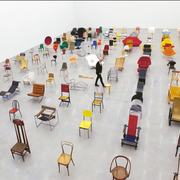Hybrid workplaces
Designing smart workplaces with key strategies for our businesses
Summer is a time of year when I can reflect more calmly on what's going on around me. And I don't just mean to contemplate what happens within the professional field, but to acquire a sense of where I am at each moment and what the space in which I am offers me. I think I will explain myself better with an example: this August I was able to take a small vacation, a short break to recharge energy after more than a year of great intensity at many levels. Of course, as happens to many other professionals, my disconnection could not be total, and I had to combine my playful and didactic immersion in the cultures and cities that I have been able to visit this August with hours of work in hotels, restaurants and outdoor spaces. And while I was doing this, I couldn't help but think of the article that we at WITHYOU dedicated at the time to Workation. A solution that is very seductive but that, realistically, is not applicable to all professionals. And it was while reflecting precisely on this that the following question arose: "then what more alternatives for the future do companies and professionals have to adapt to this rapidly changing world?"
The need for adaptation that has also challenged us within the professional field has led us to face a hybrid work model. Many of us have been the organizations that demonstrate great agility and resilience by acclimatizing quickly, implementing provisional measures to guarantee the continuity of our businesses. But now we're in another phase, one that requires us to plan how to get our teams, or part of them, back to their jobs within the company safely. And from there arises the harsh one that I referred to in the entry of this article, and that for a few weeks I have dropped in conversations with friends and colleagues, inviting us to let ourselves be carried away by, what have been, interesting debates about it: what is our long-term strategy for hybrid work and how can we ensure that it succeeds?
The need for a long-term strategy to ensure the future of business.
Hybrid work is more than extending flexibility to our work teams and employees; in reality, it is an opportunity to fundamentally improve the way in which work is done, in how teams collaborate and in maximizing the experience and expertise of the entire group. To reap the benefits of the hybrid workplace, we need a long-term strategy to deliver experiences in what we need to start calling smart workplaces, whose location extends beyond the walls of a single location or building.
In my opinion, there are two key points when it comes to laying the foundations for hybrid work:
1. Design a hybrid workplace plan
According to the article "The hybrid workplace model" by Dark Stevens for webex in 2020, 77% of large organizations considered a cultural change by establishing greater flexibility to their work teams in the wake of the pandemic caused by COVID-19; and 53% planned to optimize their office space.
The office is the central hub for people to engage in rich collaborative experiences, establishing strong relationships, team engagement, a good work environment, and encouraging participation, training, and education.
As an increasing number of employees visiting the office are unfamiliar with their environment, technology will be needed to help them find the right space to work. A small office space provides an opportunity to expand smart, technology-driven experiences across all spaces; this will be the new standard employees expect from their new smart workplaces.
2. Equip remote workers with the right tools
The most important option when it comes to powering remote teams is choosing the right collaboration platform. In my case, when facing this point, I pointed out a series of questions that I consider necessary to be able to answer before making the right decision: Can I extend the same capabilities to remote workers and workers in the office? Can people easily switch between messaging, calls, and online meetings? If we create a virtual whiteboard, can the entire team access it from anywhere? Can the people on the team expect the same experience of technology, from home as in the office?
Providing remote workers with the right technology is essential to the continuity of any business, but the organizations that emerge strongest from the pandemic are those that are thinking strategically, with a long-term vision for the future of their businesses; and, from modesty, I believe that in WITHYOU we are within this segment. Building the foundation for the hybrid workplace in the early phases will ensure that our organization is well positioned to adapt and excel for years to come; each in its sector, of course.
Next-generation experiences in all spaces.
If I look back (and without leaving beyond just a year) the workplace of the past consisted of being present in a single physical place. The future is all about flexibility and combined face-to-face and remote collaboration. For the hybrid workplace to truly redefine our businesses, physical spaces must merge with virtual spaces, and for that, we need the help of technology. This requires intuitive software and smart devices that not only provide excellent collaboration, but also offer insights to continuously improve experiences and allow us to easily deploy and manage any type of solution within a secure and trusted platform.
Thanks to smart workplaces, we can eliminate common meeting frustrations, optimize spaces, and create more productive environments where all members of our teams, both in person and remotely, enjoy a good experience.
The right strategy involves identifying the new purpose of offices and technology to support it, assess and address the challenges of remote work, and thus be able to invest in the right collaboration platform capable of providing us with the best solution for our new reality.
But I'm not the only entrepreneur with these doubts; Two days ago I crossed a few words with my friend and gym training partner, Carlos Estrada, who recommended that I read the report "The future of work: from the remote model to a hybrid one" by the Capgemini Research Institute. In this report I was able to verify that most companies have experienced strong productivity increases in the third quarter of 2020 by allowing employees to work remotely; however, a not so positive effect has also emerged for human teams: employees, in this 2021, are weighed down by an overwhelming feeling of being "always connected".
According to the same report, "... in the next two to three years, about three in ten organizations expect more than 70% of their employees to work remotely, up from just 10% before COVID-19, and nearly half (48%) of organizations estimate that their total office space will need to be reduced by at least 10%. In addition, about 45% of employees expect to spend three days or more per week working from remote locations in the future, indicating a rapidly increasing trend of hybrid and collaborative workplaces. "
Without a doubt, it was a very didactic and interesting reading that I encourage anyone who has the same concerns as me on this subject to read.
The office's strategy
Given what has been said so far, any reader of this article could tell me: "But, David, if the future of productivity and performance of companies, as well as the reconciliation of workers, and the optimization of spaces for Real Estate is hybrid work, why are not all companies already implementing it? ". It is not so simple. Let's think that the hybrid work model brings a new set of challenges for the office. The hybrid workplace ends up looking a lot like college, where you do most of your work at home and go to a physical location two days a week. You have to be prepared for an organization where everyone is in the office and, in turn, no one is in the office.
For this to be viable, technology needs to be used to help employees find the right spaces where they can work and collaborate as if they were table to table. Many organizations are planning changes such as moving from dedicated offices or desks to shared offices or desks where spaces are shared and temporarily reserved. In this way, companies could move their offices to premises with less m2, thus optimizing their costs, or reinventing physical spaces for the benefit of productivity or performance.
Another important point that has generated critical (and necessary) voices is how companies can guarantee the necessary tools to their teams to be able to develop teleworking. While many organizations believe that offering the possibility of taking home the computer or laptop of the office solves all the needs of their workers, it is evident that remote teams need to be equipped with the same guarantees of solvency and response capabilities that they would have in the office.
Different types of work require different types of collaboration capabilities. Determining which employees need which capabilities is not an easy task and will lead analytics to continuous optimization. But here's the dilemma: Equipping every home office with high-end collaboration solutions or the latest technology can be costly and, if not used, an unnecessary expense. But falling short in these tools can mean a loss of business capacity very detrimental to our development as a company. Undoubtedly, the strategy of our smart workplaces needs to be developed with the precision of exquisite goldsmithing work.
A successful strategy for hybrid work starts with evaluating the tools we currently use. As we design our strategy, we should look at the friction points we have today when we work from home and the ones we have when we work from the office. From there, we should have the critique and ability to stop and consider how hybrid work will evolve over time. Developing a long-term strategy with a strong collaboration platform will ensure that our businesses are well positioned to continue to develop and grow with guarantees year after year. At the very least, until a new reality makes us rethink new cultural horizons within the work and social environment, don't you think?
David Granell Moreno
CEO



